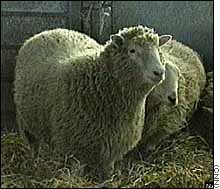The degenerative disease usually affects old animals and Dolly was only five and a half years old

by Tamara Traubman
Dolly the sheep, the first mammal cloned from an adult cell, had arthritis. Dolly is not the first sheep to get arthritis, but the degenerative disease usually affects old animals, and Dolly was only five and a half years old. The report reignited concerns that cloned animals may harbor defects, even when the animals appear seemingly normal.
Little is known about the aging process of sheep, because most of them are slaughtered before reaching the age of one year. "We will never know if Dolly got arthritis because she was cloned, or because of bad luck," said Dr. Ian Wilmot at a press conference held Friday in the sheep's pen. Wilmot headed the team of researchers who cloned Dolly.
According to Wilmot, the sign that nevertheless raised some suspicion that the inflammation developed because Dolly was cloned, apart from her young age, is where the inflammation developed. "Dolly developed the inflammation in two joints in her back leg, which are not normally susceptible to arthritis," he said. "This finding does not change much what we already know today," said Wilmot, "this is another evidence that the cloning process is quite ineffective."
Only 2% to 3% of attempts to breed sheep and cattle end in the birth of a live offspring. Some of the animals born suffer from problems such as congenital heart, lung, kidney and liver defects; Abnormally high birth weight and breathing problems. Some die a few days after birth. "All of these should be enough to deter anyone who is toying with the idea of a human tribe," Wilmot said.
Shortly after her birth, Wilmot and his colleagues discovered that Dolly had "telomeres" - structures located at the ends of chromosomes that shorten in parallel with cell aging - that look like the telomeres of an older sheep. But in spite of that, from a physical point of view, Dolly looked like a normal and healthy sheep: her weight was normal and she gave birth to three lambs, which also look healthy.
Despite the many obstacles, scientists insist on continuing efforts to perfect the clone. This is because theoretically it will be possible to create with it new tissues and organs that will replace the damaged organs in the body of patients with a variety of diseases, as well as produce premium farm animals with it. "What is important is that in the future clones will follow the cloned animals not only in the beginning, but also in the rest of their lives," Wilmot said.
Archive photo: Dolly the sheep. Only 2% to 3% of attempts to breed sheep and cattle end in the birth of a live offspring
